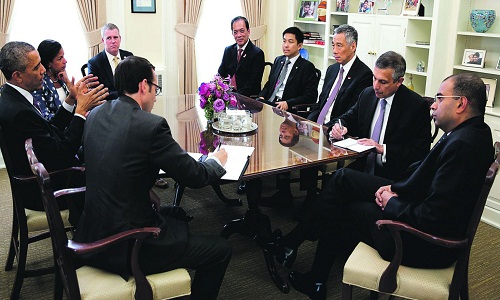FW
Noida’s garment export industry is seeing a slowdown. It has got only about 40 per cent of its usual volume of orders from the US for the back to school season. Noida is known as an apparel city. It accounts for 15 to 20 per cent of India’s garment exports. There are some 800 garment exporters operating over 4,000 units and employing over six lakh people. Major importers of Noida's garments are labels like Zara, Mango, Tesco and the products are largely sent to Brazil, US, Canada, Europe, England.
These garment exporters were already hit by a slowdown in 2016. Over 60 to 70 per cent of Noida’s garment exporters do not have orders from anywhere in the world after March 2017. Demonetization brought about systemic changes in business operations and added to costs. Existing orders have slowed down and the worry is that export orders may shift to Bangladesh, Vietnam, Cambodia.
Worldwide, importers are taking a wait and watch approach towards India because they are wondering if Indian exporters will be able to deliver at all. Meanwhile plans are on to develop an apparel cluster on the Yamuna Expressway in Noida which will involve an overall investment to the tune of Rs 300 crores. More than 100 factories will be set up in the land cluster spanning 200 acres generating jobs to lakhs of people.
Myanmar’s garment factories cater to leading international brands including New Look and H&M. But these factories indulge in violations like low wages, unlawful deductions, very low levels of unionisation, excessive and unpaid overtime, a lack of proper contracts and child labor.
The development of some garment factories has been linked with land rights violations. Local and international labor laws are completely ignored, despite continued protestations by brands sourcing from Myanmar that they are working to bring the country's garment sector in line with internationally accepted CSR standards. Many factory workers do not even receive the minimum wage, which in Myanmar is one of the lowest in the world.
There is a need for companies to carry out a risk assessment of human rights or labor rights violations before starting business in a particular state, region or production facility. The garment industry is one of the most labor-intensive manufacturing industries in the world. Clothing companies are constantly on the lookout for production locations that can make clothes more quickly and at lower costs. Over the past few years, Myanmar has rapidly become a popular sourcing destination for the garment industry – due to a huge pool of cheap labor and favorable trading conditions.
Indorama has released a new Inviya variant named I-400. This is a fourth generation polymer. I-400 polymer is robust in terms of chemical composition along with high elongation and excellent recovery at the finished garments stage. The high elongation provides a wider window to yarn manufacturers during ring spinning and texturizing. Robust chemical composition is achieved by a proprietary recipe which leads to stronger resistance to alkali, acids, chlorine, a characteristic vital for garment wash and finish.
The modulus properties of the polymer in terms of running load lead to excellent recovery and minimal growth at the garment stage, which is a key requirement for active and sports clothing, whether it is a woven or knitted outfit. Above all I-400 strongly contributes to retaining the shape of garment after even repeated washes and hence enhances the active life of the garment, leading to customer satisfaction.
Indorama is synonymous with pioneering advancements in manufacturing of polymers for applications in textile and apparel production. Indorama launched Inviya, the freedom fiber, in 2012. This is an advanced spandex fiber that can be readily used together with cotton or synthetic filament yarns. Inviya is specifically conceived for applications expanding across stretch denim, sportswear, active wear, bottom wear, intimate garments, innerwear, socks, surgical, medical applications and much more.
US specialty retailer Gap’s same store sales for the fourth quarter of its 2016 fiscal year were up two per cent compared with a decline of seven per cent in the same quarter last. Net sales increased one per cent in the fourth quarter of 2016.
The quarter included good business from the crucial holiday season. Same store sales were up two per cent for the holiday months of November and December. Comparative sales for its Old Navy global division increased 12 per cent during the holidays. Same store sales for its Gap Global division experienced an uptick of one per cent. The Banana Republic global division reported a decline of seven per cent.
The apparel and accessories retailer is struggling to attract shoppers to its Banana Republic stores. It has been controlling inventories and trying to replicate the success of its low-end Old Navy brand at its Gap and Banana Republic chains. Gap has been trying to reduce promotions and sell more merchandise at full price. However, shoppers are increasingly looking for deeper discounts. Chic and trendy clothes at lower prices from off-price, online and fast-fashion retailers such as H&M, Forever 21 and Inditex’s Zara are also luring shoppers away.
The 8th edition of Shanghai International Digital Printing Industry Fair (TPF 2017) TPF, the digital printing fair, will be held from April 19 to 21, 2017. The fair is expecting to attract over 230 exhibitors and 16,000 visitors from home and abroad.
The exhibits will include digital printing machines, printing consumables, design software and all the products on the supply chain of digital printing related to technology, dyeing, textile digital printing, textile machinery, printing, paper, ink and various printing products. Over 25 workshops and technical presentations will be held.
As the most influential digital printing trade fair in Asia, TPF 2017 will integrate overseas media and information to provide the best solutions to the challenges and applications of the digital printing industry. The show will facilitate exhibitors to gain more opportunities to identify overseas purchase requirements, display new products and technologies, and acquire overseas orders.
With China’s focus on environmental-friendly development, the textile industry is keen on implementing sustainable development and green manufacturing. Speedy sampling, green and environmental-friendly, cost-saving digital printing are the watchwords. TPF is built around the concept of professional, scientific, innovation in purchasing, ordering, and technology development.
The worldwide digital textile printing market for garment, home décor and industrial applications is expected to experience a growth of around 34 per cent CAGR to 2019.
Candiani the Italian denim maker uses two ingredients to clean up denim manufacturing considerably. Kitotex, a polymer is used as an ingredient in the dyeing and finishing process. It allows the mill to cut down water and chemicals and operate at lower temperatures. The substance is biodegradable and, after the production process, it can help purify discharge water. To consumers, Kitotex offers anti-bacterial, ant-static and anti-mite benefits.
Then there is indigo juice which reduces water consumption, chemicals and energy in the laundry process. During the dyeing process, mills keep the indigo superficial on the yarn, meaning, once the jeans is washed in the laundry, only a small amount of water and energy is needed to wash it down. Indigo Juice can be used with sustainable laundry treatments, including laser, ozone and ice.
So one pair of jeans with Kitotex and indigo juice, requires 75 per cent less water than conventional denim and 65 per cent less chemicals. During washing process, Kitotex and Indigo Juice denim consume 60 per cent fewer chemicals and 83 per cent less water than conventional denim jeans that look the same. Kitotex and Indigo Juice also require fewer treatments.
Bangladesh’s export earnings for the first seven months of fiscal 2016-17 went up 4.36 per cent compared to a year earlier. And receipts from garment exports, which typically account for 80 per cent of export receipts, were up 3.05 per cent year-on-year and 4.65 per cent month-on-month.
The country’s garment exports to the US, the country’s single largest export destination, declined 1.49 per cent during the January-November period of 2016. Garment exports to the UK, the third largest destination, declined 5.19 per cent in the first six months of the fiscal year. The jute and jute goods sector was one of the top performers during the July-January period, with shipments rising 14.05 per cent year-on-year. Shipments of leather and leather goods grew well during the seven-month period, up 12.18 per cent year-on-year. Furniture exports soared 23.37 per cent and pharmaceuticals 8.51 per cent.
Home textile exports increased 1.42 per cent and plastic products 45.74 per cent on the back of a ten per cent cash incentive on shipments. Among the poor performers, frozen and live fishes exports declined 0.80 per cent. Exports of petroleum byproducts declined 28.24 per cent.
Bangladesh has set an apparel export target of 50 billion dollars by 2021. But to achieve this more than 12.25 per cent export growth is needed every year.
"The 24th edition of Milano Unica, the Italian Textiles and Accessories Trade Show, held at Fiera Milano Rho from February 1 to 3, closed with positive sentiments especially from exhibitors, with regard the quality of contacts registered, thanks to the accurate selection made by the organisers. The edition included 427 exhibitors, of whom 300 were Italian, 65 European and 40 Japanese and 22 Korean."

The 24th edition of Milano Unica, the Italian Textiles and Accessories Trade Show, held at Fiera Milano Rho from February 1 to 3, closed with positive sentiments especially from exhibitors, with regard the quality of contacts registered, thanks to the accurate selection made by the organisers. The edition included 427 exhibitors, of whom 300 were Italian, 65 European and 40 Japanese and 22 Korean.
Ercole Botto Poala, President of Milano Unica inaugurated the fair. With a strong foreign participation, particularly important was the return of companies from the Russian Federation (+34 per cent). A growing trend is the participation of companies from the UK (+4 per cent), US (+2 per cent), Canada (+29 per cent) and China (+6 per cent), despite the concurrent occurrence of the Chinese New Year. At the same time participation from Japan and Turkey has gone down. The number of German operators too reduced.
Gearing up for the next edition

“The 25th edition of Milano Unica will be an additional confirmation that the route focusing on innovation and quality – the one that we are consistently pursuing – is the winning one not only from an image perspective, but also in terms of the commercial and marketing results obtained. This route, meant to make Milano Unica the perfect vehicle to showcase the excellence of Made-in-Italy and Made-in-Europe production, needs additional action, but we are confident and positive. Milano Unica will increasingly become an exhibition to show excellence, innovation and creativity to the world, confirming that fabrics and accessories – above all those Made in Italy and also a selection of the best Made-in-Europe products – represent the starting point for inspiration of international fashion,” commented Poala.
Poala said the interest attracted by MU365, a platform for selected customers to establish face-to-face with exhibitors every day, at any time round the clock, created in collaboration with the US Sundar startup, is proof of their focus on technology and determination to contribute to the growth of the industry. The said this is also a way to attract young talent and create opportunities for them. He urged participants to invest in young talent, adopt a startups, to stimulate action. “I also would like to underscore the importance of the ‘Back to School’ project, which closed with the enthusiastic success of Sir Paul Smith’s presentation before approximately 1,000 students attending international fashion schools. Ahead of us lies the challenge of the July edition, but I am confident that we will face it successfully,” addded.
Focus on youth
Keeping youth in focus the ‘Magazzini Aperti’ project developed in collaboration with Regione Lombardia, Piattaforma Sistema Formativo Moda and Milano Unica presented work by final year students of 10 fashion schools were presented, using fabrics and accessories donated by Milano Unica exhibitors.
The Trend Area, restyled both in terms of space and creativity, and the consolidation of the Japan Observatory and Korea Observatory, which demonstrated the complimentarity of excellent products was great attraction for visitors and exhibitors alike.
"America produces things at the top of the pile: airplanes, wind turbines, solar panels. These are not things competitors can quickly imitate as it requires expertise and innovation. They are products that take years to develop. China or Mexico can’t just get some guys in a room and give them aluminum foil and tell them to make a 747."

America produces things at the top of the pile: airplanes, wind turbines, solar panels. These are not things competitors can quickly imitate as it requires expertise and innovation. They are products that take years to develop. China or Mexico can’t just get some guys in a room and give them aluminum foil and tell them to make a 747.

In such a scenario, America needs to answer a simple question as to why it should spend time making T-shirts and socks when they can train unemployed former textile workers to program, and help them get jobs in new industries. Long gone are the days of thousands of men standing shoulder to shoulder in a Ford factory making Model Ts. Now robots paint and weld, plus machines that help auto workers put cars together. The next great middle-class job isn’t the auto assembly line employee who works in the GM plant for 40 years and retires. It’s the computer programmer who helps make the robots that build the cars.
Game changing revolutions
The time is right for America to enact game-changing trade policies. The countries in East Asia are turning to the US for leadership and, for protection. They want to trust US, like Germany did, as a reliable and stable partner for trade and security. Even Vietnam, formerly its enemy, now seeks to become its friend.
They want to help it make the 21st century the second American Century. It is in their interest to help the country and in its own interest to take their help. Instead, the countrymen or rather the government at the helm is too busy making America ‘great’ again while losing ‘bigly’ in the process. The initial impact could be praising for the President but it would rather be short term.
So the next time you buy a T-shirt at Target, take a look at the label. There’s a good chance it came from somewhere that would have been a part of the Trans-Pacific Partnership. As you’re looking at that tag, please think about the Vietnamese garment worker who would have benefited from a shorter working day and from being able to unionize. Consider the family who could have fed their children better, worked in better conditions and enjoyed more health and safety protections.
For the first eight months of this year, Thai garment shipments fetched $1.95 billion, a slight increase of one per cent from the same period last year. However, they are expected to soar in the remaining months due to the festive season spending spree. Thailand’s garment exports are expected to grow by two per cent this year.
Right now the country can avail of GSP for exports to the European Union but this privilege may end early next year. If this happens, Thai garment exports to the EU would be subject to a 12 per cent import tariff, up from the current 9.6 per cent, making Thai shipments less competitive in the EU market, particularly against Vietnamese products. This may induce Thai manufacturers, particularly medium and large-scale operators, to relocate their production bases to Vietnam or Myanmar.
Slowing demand from the US and EU has been offset by a rise in Thailand’s exports to Asia - including China, Hong Kong, Korea and Japan - which now account for half the country’s total exports. Some 24 per cent of Thailand’s exports are within Asean and China takes up 12 per cent. But next year the country’s garment exports can grow five per cent if global economic conditions are in good shape.












